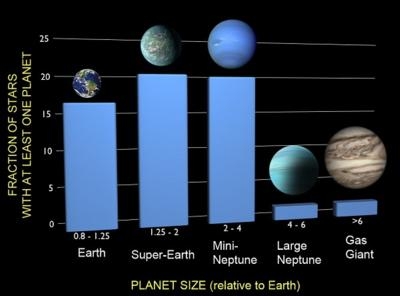Mon, Jan 14, 2013
Milky Way Galaxy May Contain 17 Billion Planets Of Similar Size
The quest to determine if planets like Earth are rare or common is taking another stride forward. Using NASA's Kepler spacecraft, managed by NASA Ames Research Center, astronomers are beginning to find Earth-sized planets orbiting distant stars. A new analysis of Kepler data shows that about 17 percent of stars have an Earth-sized planet in an orbit closer than Mercury. Since the Milky Way has about 100 billion stars, there are at least 17 billion Earth-sized worlds out there.

Francois Fressin, of the Harvard-Smithsonian Center for Astrophysics (CfA), presented the analysis today in a press conference at a meeting of the American Astronomical Society in Long Beach, CA. A paper detailing the research has been accepted for publication in The Astrophysical Journal. The research team found that 50 percent of all stars have a planet of Earth-size or larger in a close orbit. By adding larger planets detected in wider orbits up to the orbital distance of the Earth, this number increases to 70 percent.
Extrapolating from Kepler's currently ongoing observations and results from other detection techniques, scientists have determined that nearly all sun-like stars have planets. Planets closer to their stars are easier to find because they transit more frequently. As more data are gathered, planets in larger orbits will be detected. In particular, Kepler's extended mission will enable the detection of Earth-sized planets at greater distances, including Earth-like orbits in the "habitable zone," the region in a planetary system where liquid water might exist on the surface of an orbiting planet.
Kepler is the first NASA mission capable of finding Earth-size planets orbiting in or near the habitable zone of the host star. NASA's Ames Research Center, Moffett Field, CA, is the home organization of the science principal investigator, and is responsible for the ground system development, mission operations, and science data analysis.
(Image provided by NASA)
More News
Airport Marking Aids Markings used on runway and taxiway surfaces to identify a specific runway, a runway threshold, a centerline, a hold line, etc. A runway should be marked in ac>[...]
"It is extremely difficult, if not impossible, for manned aircraft to see a drone while conducting crop-enhancing and other aerial applications at low altitudes and high speeds. We>[...]
Aero Linx: The Skyhawk Association The Skyhawk Association is a non-profit organization founded by former Skyhawk Pilots which is open to anyone with an affinity for the A-4 Skyhaw>[...]
“The T-54A benefits from an active Beechcraft King Air assembly line in Wichita, Kansas, where all required METS avionics and interior modifications are installed on the line>[...]
Aero Linx: Aerostar Owners Association The Association offers the Aerostar Owner a unique opportunity to tap an invaluable source of information concerning the care and feeding of >[...]
 ANN's Daily Aero-Term (04.28.24): Airport Marking Aids
ANN's Daily Aero-Term (04.28.24): Airport Marking Aids Aero-News: Quote of the Day (04.28.24)
Aero-News: Quote of the Day (04.28.24) ANN's Daily Aero-Linx (04.28.24)
ANN's Daily Aero-Linx (04.28.24) Aero-News: Quote of the Day (04.29.24)
Aero-News: Quote of the Day (04.29.24) ANN's Daily Aero-Linx (04.29.24)
ANN's Daily Aero-Linx (04.29.24)



